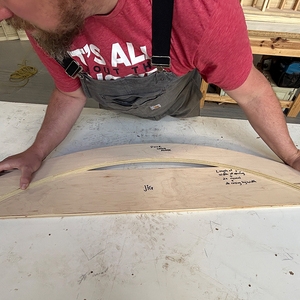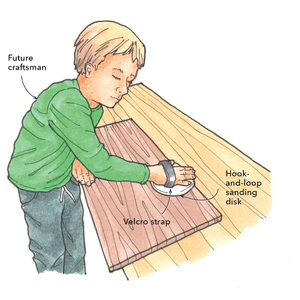I have a question about the water level in the sump pump pit in my basement.
The float switch is currently set so that the water level is about 6-7 inches below the floor level. Is this normal?
The sump pump is set on bricks to lift the bottom of the pump up about 2-3 inches. The water is level with the top of the inlet pipe to the sump pump pit.
I am about to finish the basement, and I am wondering if I should lower the level of the pump or float. Is the water level affecting the moisture content of the floor slab? Or causing some other unseen problem?
Thanks for your input.
Scott B.



















Replies
You only need to lower the water a little below the slab. Otherwise you are trying to lower the water table on your property and wasting money.
first rule - if it ain't broke, don't fix it
Second point - lowering it is likely to make it cycle on and off more often and wear it out sooner, while making agravating noises,all with litle orno gain, unless you see some problem happening from the way it is set now.
You want the water level to be roughly 6" below the surface, to avoid moisture wicking upward. The more the better, but beyond 10-12 inches it probably doesn't make much difference.
Keep in mind that the water level is controlled by three factors:
1) The "off" (lower) setting of the switch
2) The "on" (upper) setting of the switch
3) The amount of drain-back that occurs after the pump shuts off.
The lower setting must be high enough that the pump never sucks air.
You want the upper setting high enough above the lower one that the pump doesn't cycle too often (though "too often" is somewhat subjective). You also, of course, want the upper setting low enough that the pit doesn't overflow or get too close to the surface. And lower is better in terms of providing a safety factor in the event of a power or pump failure.
The lowest static level is determined by the low setting and the drain-back amount. Drain-back can be limited by installing a check valve (if you don't already have one).
You can physically lower the pump to lower both settings, but you increase the amount of sand/silt/trash drawn into the pump. In some cases this is an issue, in others there's so little such trash that there's no sense in not having the pump all the way down.
You can also buy a different pump -- sometimes you'll find one that can drain lower by 2-4 inches before sucking air vs the standard tract home grade pump.
The part that concerns me is that the water is level with the top of your drain tile. That means your drain tile is constantly full of none moving water and water that doesn't move results in sediment. The other issue I have with this is that your drain tile is already full of water. If your pump stops for any reason, you have no freeboard so to speak versus an empty tile that would have to fill up before it starts to come up between your slab and foundation.
I disagree that your pump will run more by setting it lower. The water around your house is going to move into the pit at the same rate no matter what level you set the pump at. Once you have drained the water down to the lower level and you establish equilibrium again, you are going to be moving the same amount of water out of the system. Initially, yes there will be more because you are establishing a lower level but once that level is reached, there is no reason the water volume will increase.
The pump will run more often if you lower the top setting and not the bottom. Whether it's enough to be a problem is questionable.
I agree that it's not good to have standing water in the tile, for a number of reasons.
>>The water is level with the
>>The water is level with the top of the inlet pipe to the sump pump pit.
I agree wih cussnu - the water level should be below the bottom of the inlet pipe. (The lower the better, IMO)
If your water table level is above that you've got bigger problems than how often the sump cycles.
With the water level above the bottom of the inlet pipe, water which is supposed to be drained away from the foundation and pumped out by he sump will remain there, saturating the soil around he foundation and potentially (i0 affecting the soil load bearing capacity and (ii) leading to water penetration into the basement (or crawl) through the footer/wall cold joint..
My church, fairly large square footage on a slab, had settlement problems until we adjusted the sumps so the level was below the inlet pipe, which reduced (almost eliminated) the settlement problem.
As a home inspector, I see this situation at times. Aside from my direct experience with my church, I can't say that I've seen more problems where the sump water level is too high (but I can't say I've seen it enough to draw conclusions), but it is a condition which I recommend be remedied.
I know with mine in a non-rainy period, my drain tile will buy me at least a day before it completely fills and then forces its way into the basement. If my tile were already full, I would get a couple of hours before water shows up. That difference is huge when you are talking about being away from home 8-10 hours working. Many people don't even get itno their basements every day so just having that empty tile as a cushion is a big help. (My basement is almost 2000 sq ft so I have nearly 200 running feet of tile.)
I can see the water being a problem with the foundation as well. Around here, the footings will sit in clay which expands ALOT when it gets wet so I know you would get a great deal of movement out of it. my driveway pad moves up and down over two inches from spring (wet) to summer (dry)
Yeah, you can sort of picture water flowing downhill into the drain tile. If the tile are full then the water drains at a shallower angle and won't drain as rapidly. In rainy weather where water might tend to come into the corners of the basement this could make a difference of the basement being wet or dry.
Once the pit's drained below the tile, though, it won't make much difference.
I've recently finished a drain system which is collecting water from a massive roof and a parking lot sloaping toward an office building. It's in the country and had an old concrete septic set-up that was abandoned over 15 years ago. So I ran two drain baskets at the lowest two points in the parking lot and connected them to a 3" run of PVC to the old septic tank. One we had to cut 8' of concrete out and the other I drilled to with a water drill and sawed the basket out with my wormdrive. The downspout from the gutter feeds into the 3" line as well. At the septic, now collection point, I set up a sump that pipes the water to a runoff drainage ditch about 150' away.
Before all this, whenever it rained, water would seep into the office in half a dozen places without any obvious source. The groundwater table is so high it was literally flooding the office through the slab. When I was in the septic tank after cleaning it thoroughly, I perforated the walls and floor to allow groundwater a place to collect. So far, the system has been quite successful because it's finally dropping the groundwater level. It also keeps pace with a Texas downpour since it's about 1,000 gallons of capacity. The sump is set in a basket with bricks inside about 5' below grade so it works a little hard at times but it also takes a lot of water to activate it and that's only when it's raining.
Thanks to all for your comments .....
I do agree that if it aint broke, dont fix it. ... I just wasn't sure if it aint broke ... Of course, as I tell the guys at work , if it aint broke, let me work with it for a while, I can break it for ya ...
The house is about 10 yrs old, so the sitution has been this way for a while. I guess I could just check to see if the slab is too wet to put a floor down and leave it at that.
My basement is about 2000 sq foot, and it is 9 foot deep rather than the 8 foot deep basement that the neighbor has. I guess I am lowering the local water table for him, rather than the other way around. My pump cycles more than his does.
There is never water in the basement, unless the pump fails, then after a good rain, the water might seep in through the cold joint at the base of the walls. I have had a couple of pumps fail since I bought the house. After one pump failure (the float stuck), I had about 2" of water in the basement. A good back-up pump system is called for. Any comments on SumpPro.
If I do try to fix the situation by lowering the pump (by removing the bricks that the pump sits on) what might be the effect on the foundation as it dries out?
Thanks again,
Scott B
Yeah, it's a good point about the downspout extensions -- they can make a remarkable difference.
Also survey the area around the house -- make sure the soil slopes away all around, and that there's no spot where water can stand at least ten feet in every direction.
We had a driveway slab that was slanting toward the house -- had that mud-jacked and it made a major difference. (Patio slabs are an even more likely source of such a problem.)
Drying out the foundation footings generally shouldn't cause serious problems with the foundation. In really expansive soils (eg, Red River clay), if the soil becomes TOO dry you can see some settling, but that generally only happens during drought conditions.